Discover the Best Smoked Salmon Brine Recipe: There’s something unforgettable about the first time you craft your own smoked salmon. For me, it was a chilly December evening, just days before Christmas, when I decided to prepare smoked salmon for our family gathering. I was nervous—intimidated by the idea of curing fish at home. But once I pulled the glistening fillets from the brine, ready for the smoker, I was hooked. The aroma, the deep flavor, the silky texture—it was a revelation. That single experience opened my eyes to the magic of brining, and how it transforms ordinary salmon into a gourmet masterpiece.
In this guide, you’ll learn how to master the art of brining salmon for smoking—an essential step that enhances flavor, firms up the flesh, and sets the stage for a delicious final result. We’ll explore the subtle but important differences between cold smoked salmon brine and hot smoked salmon brine, and break down the long-debated question: wet brine vs dry brine.
Whether you’re aiming for a classic salty brine, a sweet maple cure, or a spicy kick, this no-fail smoked salmon brine recipe has you covered. Designed for both beginners and experienced smokers, this guide ensures your salmon will always impress. Let’s dive in!
Best Smoked Salmon Brine Recipe: Easy Wet & Dry Brining Guide
Course: LunchCuisine: AmericanDifficulty: Easy6 – 8
servings15
minutes2
hours~200 kcal per serving (varies depending on cut and brine method)
kcalA simple and flavorful brine recipe for perfectly seasoned smoked salmon using easy wet or dry methods.
Ingredients
Dry Brine Ingredients:
1/2 cup kosher salt
1/2 cup dark brown sugar
1 tablespoon black pepper (coarsely ground)
1 tablespoon garlic powder (optional)
Zest of 1 lemon or orange (optional for citrus notes)
Fresh dill sprigs (optional for layering)
🔹 Wet Brine Ingredients:
4 cups cold water
1/2 cup kosher salt
1/2 cup brown sugar
1 tablespoon whole black peppercorns
2–3 bay leaves
3–4 garlic cloves, smashed
2 tablespoons maple syrup or honey (optional for sweetness)
Lemon slices or zest (optional for brightness)
Fresh dill (optional)
Directions
- Dry Brine Method:
Prepare the Brine Mix:
In a bowl, combine kosher salt, brown sugar, black pepper, and any optional citrus zest or garlic powder. - Layer the Salmon:
In a glass or non-reactive container, sprinkle a thin layer of the brine mix on the bottom.
Lay the salmon skin-side down, then generously coat the top and sides with the dry brine. - Refrigerate:
Cover and refrigerate for 8–12 hours (up to 24 hours for thicker cuts). Liquid will be drawn out into the container. - Rinse and Dry:
Rinse the salmon under cold water to remove the brine mix. Pat completely dry with paper towels. - Form a Pellicle:
Place the salmon on a rack and refrigerate uncovered for 2–4 hours until a tacky surface (pellicle) forms. This helps smoke adhere. - Wet Brine Method:
Make the Brine:
In a large container, stir together cold water, kosher salt, brown sugar, peppercorns, garlic, bay leaves, and other optional flavorings until dissolved. - Submerge the Salmon:
Place salmon in the brine, making sure it’s fully submerged. Weigh down with a plate if necessary. - Refrigerate:
Brine in the fridge for 8–12 hours. - Rinse and Dry:
Remove salmon from brine, rinse under cold water, and pat dry thoroughly. - Form a Pellicle:
Place salmon on a wire rack in the fridge for 2–4 hours until a sticky pellicle forms.
Table of Contents
Ingredients for a Perfect Brine for Smoked Salmon
Creating the best brine for smoked salmon starts with simple, quality ingredients that build deep flavor while enhancing the texture of the fish. Whether you prefer a classic wet brine for salmon or a flavorful dry brine for salmon, the basics are the same: salt for curing, sugar for balance, and aromatic add-ins for personality.
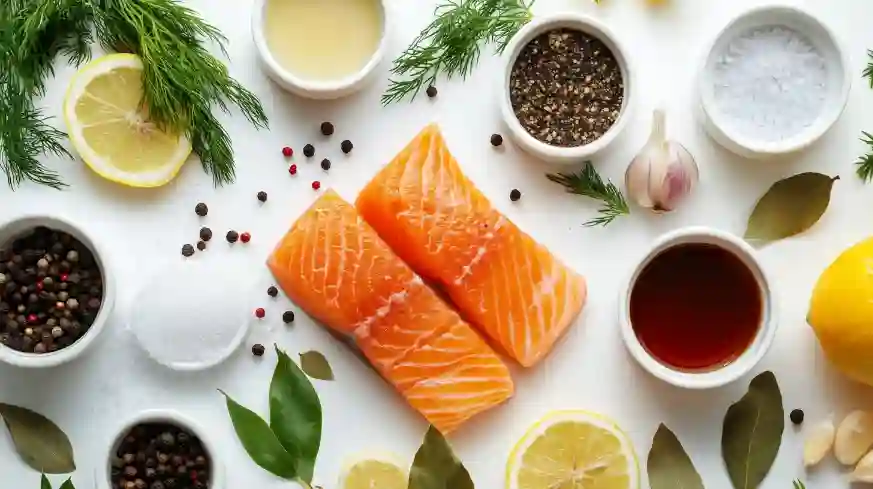
🧂 Essential Ingredients for Salmon Brine:
- Kosher salt: This is the foundation of any salmon brine recipe. Its coarse texture and purity make it ideal for curing.
- Brown sugar: Adds subtle sweetness and helps balance the salt. For a richer taste, opt for dark brown sugar.
- Black peppercorns: Offer warmth and spice without overpowering.
- Bay leaves: Add a gentle herbal note and depth of flavor.
- Water (for wet brine): Acts as the carrier for all ingredients to soak into the fish evenly.
🍯 Variations for Dietary Needs:
- Gluten-free smoked salmon brine: Ensure all sauces and spices are gluten-free (especially soy or teriyaki).
- No-sugar salmon brine: Skip the sugar and replace it with a pinch of stevia or monk fruit for a low-carb version.
- Honey brine for salmon: Swap maple syrup or brown sugar with raw honey for a natural, floral sweetness.
🌿 Popular Flavor Profiles:
- Garlic & herb brine: Add crushed garlic, thyme, and rosemary.
- Dill & lemon brine: Fresh dill, lemon zest, and a touch of white wine vinegar.
- Maple salmon brine: A classic for smoked salmon—swap sugar with real maple syrup.
- Teriyaki salmon brine: Include gluten-free soy sauce, fresh ginger, garlic, and a splash of mirin.
⚖️ Salt-to-Sugar Ratio:
A solid rule of thumb is 4:1 salt to sugar by volume for a savory brine, or 2:1 for a sweeter cure. This balance ensures the salmon cures properly without becoming overly salty or overly sweet.
For an easy pantry-friendly smoked salmon brine, all you need is salt, sugar, pepper, and water. The magic is in the proportions—and the patience.
How to Brine Salmon for Smoking – Step by Step
Brining salmon before smoking is a crucial step that enhances both the flavor and texture of the fish. Whether you’re cold smoking for silky slices or hot smoking for a flaky finish, a good brine ensures your salmon turns out moist, savory, and deeply infused with flavor. Here’s your step-by-step guide on how to brine salmon for smoking like a pro.
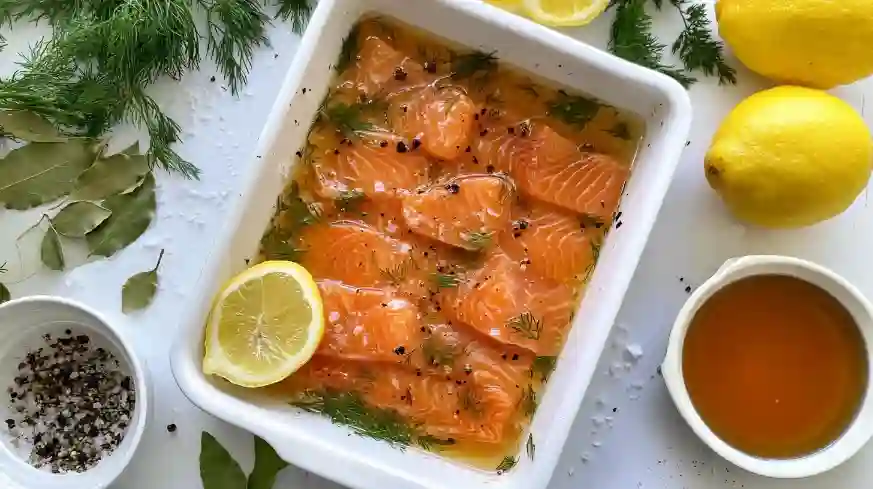
🐟 Step 1: Prepare the Salmon
Begin with fresh or fully thawed salmon. Remove pin bones using tweezers and keep the skin on for better structure. Pat the fillets dry with paper towels. For even curing, try to cut your salmon into similar-sized pieces, especially when working with thick fillets.
🧂 Step 2: Choose Wet or Dry Brine
Wet Brine for Salmon:
In a large container, dissolve kosher salt and brown sugar in cold water using the right salt-to-sugar ratio (typically 4:1 for savory or 2:1 for sweeter brine). Add flavorings like peppercorns, bay leaves, garlic, or lemon slices. Submerge salmon completely, cover, and refrigerate.
Dry Brine for Salmon:
Mix kosher salt and sugar in your preferred ratio. Lay the fillets skin-side down on a tray. Generously cover the flesh with the dry brine mix. Optional: Add herbs, zest, or spices. Wrap the tray and refrigerate.
⏱️ Step 3: Brining Time for Salmon
Brining time depends on salmon thickness and your smoking method.
- Cold smoking (low heat, long smoke): Brine for 8 to 12 hours, up to 24 for thick fillets.
- Hot smoking (higher heat): Brine for 4 to 8 hours, depending on thickness.
For thin fillets (under 1 inch), err on the shorter side to avoid over-curing.
💧 Step 4: Rinse and Dry the Salmon
After brining, gently rinse the salmon under cold water to remove excess salt and sugar. Pat dry thoroughly with paper towels. Place the salmon uncovered on a rack in the fridge for 4 to 12 hours. This step forms the pellicle—a tacky surface that helps smoke adhere evenly and locks in moisture.
🔥 Step 5: Smoking the Salmon
After drying, you’re ready to smoke!
- Cold smoking: Ideal temp is 70–80°F. Use a cold smoke generator for up to 24 hours. Best for silky, cured-style salmon.
- Hot smoking: Preheat your smoker to 180–225°F. Smoke for 1.5 to 3 hours, or until the internal temp hits 145°F.
Smoker types:
- Traeger or pellet smoker: Set and forget. Use apple, cherry, or alder pellets for balanced flavor.
- Electric smoker: Great for beginners—easy temp control and consistent results.
- Charcoal smoker: Offers rich flavor. Keep temperature steady using water pans and air vents.
📝 Final Tips
- Don’t skip the drying step—moisture on the surface can ruin the smoke adhesion.
- Experiment with wood chips for subtle flavor differences.
- After smoking, cool the salmon and wrap it tightly. It actually tastes better after resting in the fridge for a day.
With this smoked salmon brining process, you’re guaranteed a rich, flavorful result every time—perfect for brunch, bagels, or gourmet meals.
Flavor Variations and Brining Tips for Salmon
Once you’ve mastered the basics of brining, it’s time to elevate your smoked salmon with creative flavors and smart techniques. Whether you’re a beginner or a seasoned home smoker, these flavor variations and brining tips for salmon will help you tailor each batch to your taste and impress your guests with gourmet-level results.
🍽️ Beginner Brining Tips
- Keep it simple: Start with a basic wet salmon brine recipe using kosher salt, brown sugar, and pepper. Once you’re confident, start experimenting.
- Use quality salmon: Fresh, firm fillets with the skin on work best for smoking.
- Measure accurately: Use a consistent salt-to-sugar ratio (like 4:1 or 2:1) to avoid over-salting.
🔥 Classic & Creative Flavor Variations
- Savory brine: Add garlic cloves, crushed bay leaves, cracked black pepper, and fresh thyme for a deeply aromatic profile.
- Sweet salmon brine: Use a mix of brown sugar and real maple syrup for a rich glaze effect—perfect for brunch boards.
- Spicy salmon brine: Stir in chili flakes, jalapeño slices, or a touch of smoked paprika for a bold kick.
- Teriyaki salmon brine: Combine gluten-free soy sauce, honey, ginger, and garlic for an Asian-inspired twist.
- Lemon-dill dry brine: Mix lemon zest, fresh dill, and kosher salt for a bright, fresh flavor that’s great for summer smoking.
🧂 Quick & Make-Ahead Brine Ideas
- Quick salmon brine: Mix salt, sugar, pepper, and water with a splash of apple cider vinegar—done in 5 minutes with pantry staples.
- Make-ahead brine: Combine ingredients in a large jar and refrigerate for up to a week. Give it a shake before using, and you’re always ready to cure salmon on the fly.
🧬 Curing vs Brining
While often used interchangeably, brining uses liquid to flavor and hydrate, while curing (usually dry) draws out moisture for a denser texture. Both methods enhance flavor, but brining results in a juicier, more tender smoked salmon, ideal for hot smoking.
🥗 Perfect Pairings for Smoked Salmon
Your freshly smoked salmon deserves equally delicious sides:
- Cream cheese and bagels
- Pickled red onions or cucumbers
- Capers and lemon wedges
- Light potato salad or herbed couscous
Whether you go traditional or experiment with sweet, savory, or spicy notes, these smoked salmon brine tips and variations offer endless ways to customize and perfect your favorite fish.

Nutritional Facts of Brined & Smoked Salmon
Smoked salmon is more than a delicious delicacy—it’s also a nutrient-rich food packed with protein, healthy fats, and essential minerals. When made with a thoughtful brine, your smoked salmon can be both flavorful and good for you. This section breaks down the nutritional profile of brined and smoked salmon, and how ingredient choices can impact the final health value.
🧂 Why Brining Matters for Health
Brining not only enhances flavor and texture—it also preserves moisture in the salmon, reducing the need for extra oil or butter. Using natural herbs, citrus, and spices adds complexity without relying on artificial additives. When brined properly, smoked salmon retains its omega-3 fatty acids, which support heart and brain health.
📊 Nutritional Profile Per 3 oz (85g) Serving
| Nutrient | Amount | Notes |
|---|---|---|
| Calories | 180–220 kcal | Slightly higher with sweet brines (e.g., honey or maple) |
| Protein | 18–22 g | Excellent source of lean protein |
| Total Fat | 9–12 g | High in heart-healthy omega-3 fatty acids |
| Sodium | 600–900 mg | Dependent on brine time and rinsing |
| Carbohydrates | 0–4 g | Varies with sugar or syrup in brine |
🥄 Ingredient Variation Impact
- Honey vs. Maple Syrup: Both are natural sweeteners. Maple adds more depth and slightly more sugar per tablespoon, while honey is lighter and more floral.
- Kosher Salt vs. Sea Salt: Kosher salt dissolves evenly and is less dense than table salt, making it ideal for controlling sodium content. Sea salt contains trace minerals but can vary in saltiness.
- Brown Sugar: Adds around 12g carbs per tablespoon used, but much of it is rinsed away post-brining, so final sugar intake is minimal.
- Citrus and Herbs: Lemon, dill, thyme, and garlic contribute no calories and enhance the flavor naturally, helping to reduce the urge for added sauces or seasoning.
💪 Health Benefits of Homemade Smoked Salmon
- Low in added fats: Thanks to the brining process that locks in moisture.
- No preservatives: Unlike store-bought versions, homemade smoked salmon contains no artificial nitrates or dyes.
- Rich in nutrients: High in B vitamins, selenium, and omega-3s.
In summary, a well-balanced smoked salmon brine recipe gives you total control over the nutritional quality. Choose clean ingredients, go light on sugar and salt when needed, and let the natural richness of the salmon shine through.
Common Brining Mistakes and How to Fix Them
Even with the best intentions, brining salmon can go sideways if you miss a few key details. Avoiding these common brining mistakes will help you achieve that perfect texture and rich flavor every time. Here’s what to watch for—and how to fix it fast.
❌ Over-Salting or Over-Brining
Mistake: Using too much salt or brining for too long can result in a salmon that’s too salty or firm to enjoy.
Fix: Stick to the recommended brine time (4–12 hours) depending on your method, and always follow a reliable salt-to-sugar ratio. If you’re unsure, start with a 4:1 salt-to-sugar base for savory brines.
💧 Not Rinsing After Brining
Popular Question: Do you rinse salmon after brining?
Yes—absolutely.
Why? Rinsing removes excess surface salt and sugar that can lead to an over-seasoned or unevenly cured final product. Gently rinse under cold water and pat dry before air-drying the fillets.
🐟 Uneven Cure or Off Flavor
Mistake: Inconsistent fillet thickness or uneven salt distribution during dry brining can lead to patches of raw texture or strange flavors.
Fix: Trim salmon into uniform pieces and apply brine evenly, covering every inch of the flesh. Massage it in for full coverage.
🔥 Dry Fish or Tough Texture
Mistake: Smoking at too high a temperature or skipping the drying step can dry out your salmon.
Fix: Always let the salmon form a pellicle in the fridge before smoking. Then, smoke low and slow—180–225°F for hot smoking—to preserve moisture and develop flavor.
🧯 Bonus Tip: Temp Control
Use a reliable thermometer to maintain even temperature inside your smoker. Fluctuations can cause uneven cooking and ruin texture.
Master these fixes and your brined and smoked salmon will be perfectly balanced, tender, and flavor-packed—every single time.
FAQs: Brining & Smoking Salmon at Home
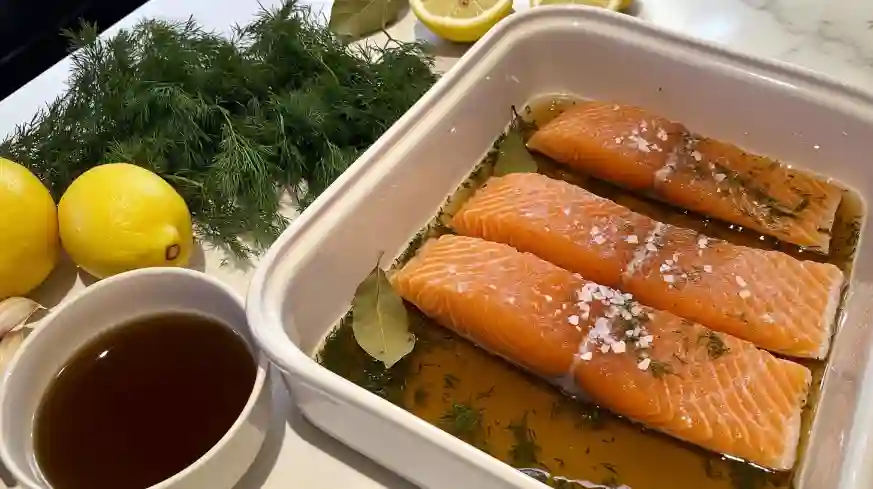
Thinking of making your own homemade salmon brine but still have questions? You’re not alone. Here are the most common queries about how to brine salmon for smoking, answered clearly to help you get flawless results from start to finish.
❓Can I prepare smoked salmon brine ahead of time?
Yes, you can make your brine for smoked salmon up to a week in advance. Store it in an airtight container in the refrigerator. Just give it a good stir or shake before using to redistribute the salt and flavorings.
❓What is the best brine for cold smoking salmon?
For cold smoking, a dry brine is often preferred as it removes more moisture and creates a firmer texture. Use a simple mix of kosher salt, brown sugar, and optional herbs like dill or citrus zest. Let it cure for 12–24 hours, then rinse and air-dry before cold smoking.
❓How long to smoke salmon after brining?
Smoking time depends on your method.
- Hot smoked salmon: Smoke at 180–225°F for 1.5 to 3 hours until internal temp reaches 145°F.
- Cold smoked salmon: Smoke at 70–80°F for 6 to 24 hours. Always brine and air-dry first for proper curing and smoke adhesion.
❓Is dry brine better than wet brine for salmon?
Both work well! Dry brine gives a firmer, more cured texture—ideal for cold smoking. Wet brine keeps salmon moist and tender, perfect for hot smoking. The best choice depends on your texture preference and smoking style.
❓How do I store brined salmon before smoking?
After brining and rinsing, store salmon uncovered in the fridge on a wire rack for 4–12 hours. This air-drying forms a sticky surface (pellicle) that’s essential for smoke absorption.
❓What flavors go best with smoked salmon?
Popular flavors include:
- Maple and brown sugar
- Lemon and dill
- Garlic and herbs
- Teriyaki-style with ginger and soy
These combinations enhance your homemade salmon brine and complement the natural richness of the fish.
Try This Smoked Salmon Brine and Share Your Results!
Whether you’re firing up your smoker for the first time or you’re a seasoned pro looking to refine your recipe, this is the best salmon brine recipe to get consistent, flavorful results every time. With step-by-step instructions, savory and sweet variations, and tips tailored to both hot and cold smoked salmon, you’ve got everything you need to create salmon that’s moist, tender, and packed with bold, natural flavor.
Don’t be afraid to experiment—try a rich brown sugar and maple brine, go fresh with lemon and dill, or turn up the heat with a spicy teriyaki salmon brine. The key is starting with this foolproof guide and adapting it to your taste.
We’d love to see what you create! Share your smoked salmon photos, tips, or flavor ideas in the comments below—your experience could inspire someone else.
Looking for more? Check out our related guides on hoPellet Grilled Salmon Perfected :The Secret to Flawless Results or whip up a quick salmon brine in minutes.
If you found this helpful, bookmark it for your next smoking session or share it with fellow BBQ lovers. Great smoked salmon starts here—now it’s your turn to make it unforgettable.

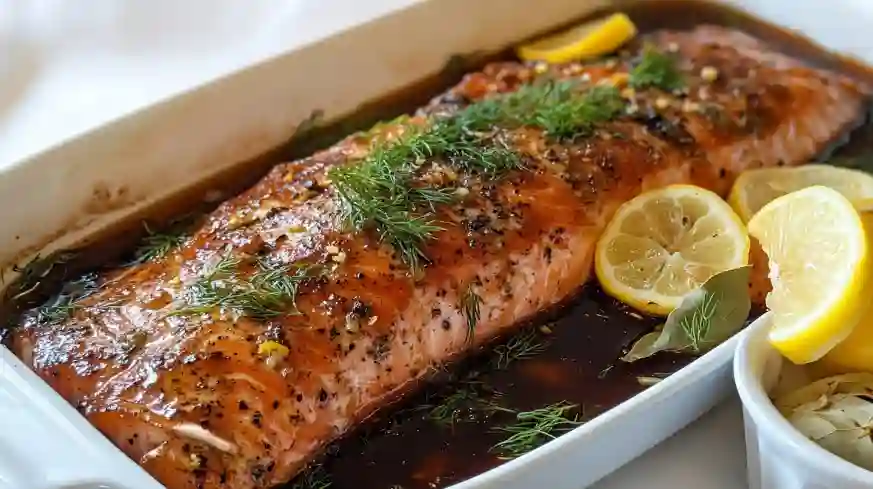
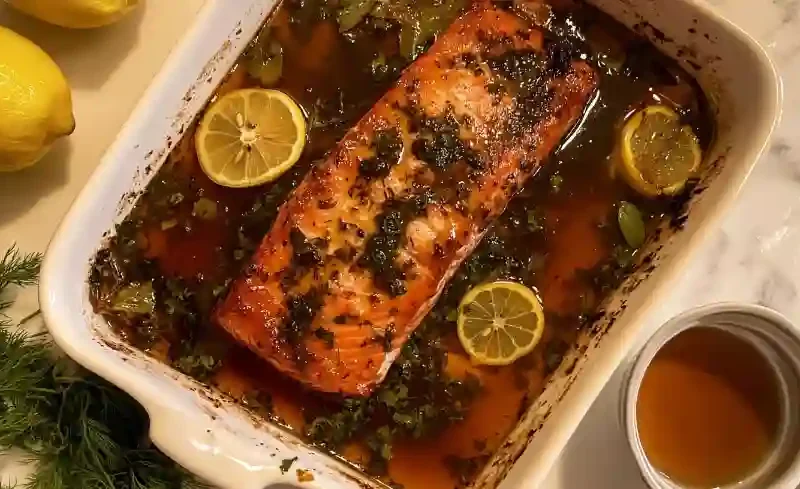
1 thought on “Best Smoked Salmon Brine Recipe: Easy Wet & Dry Brining Guide”
Comments are closed.